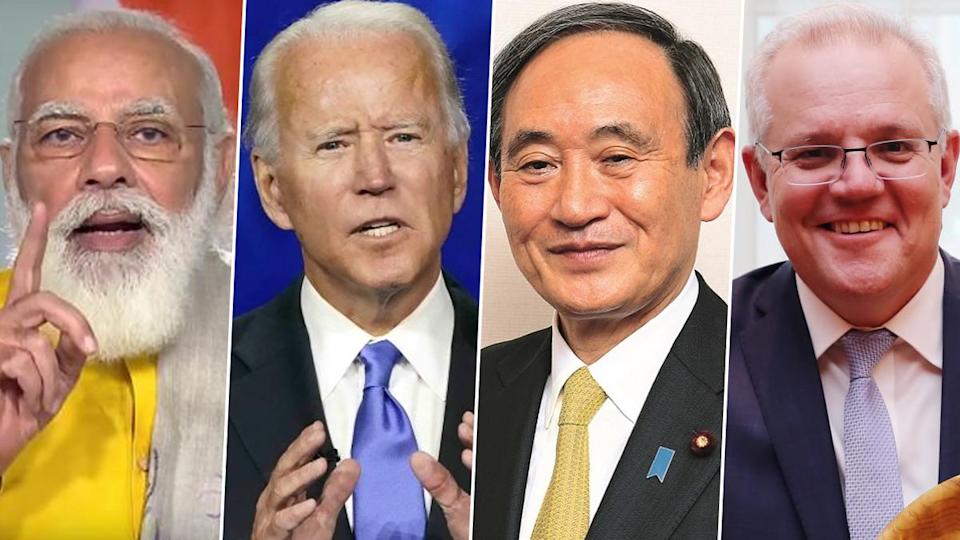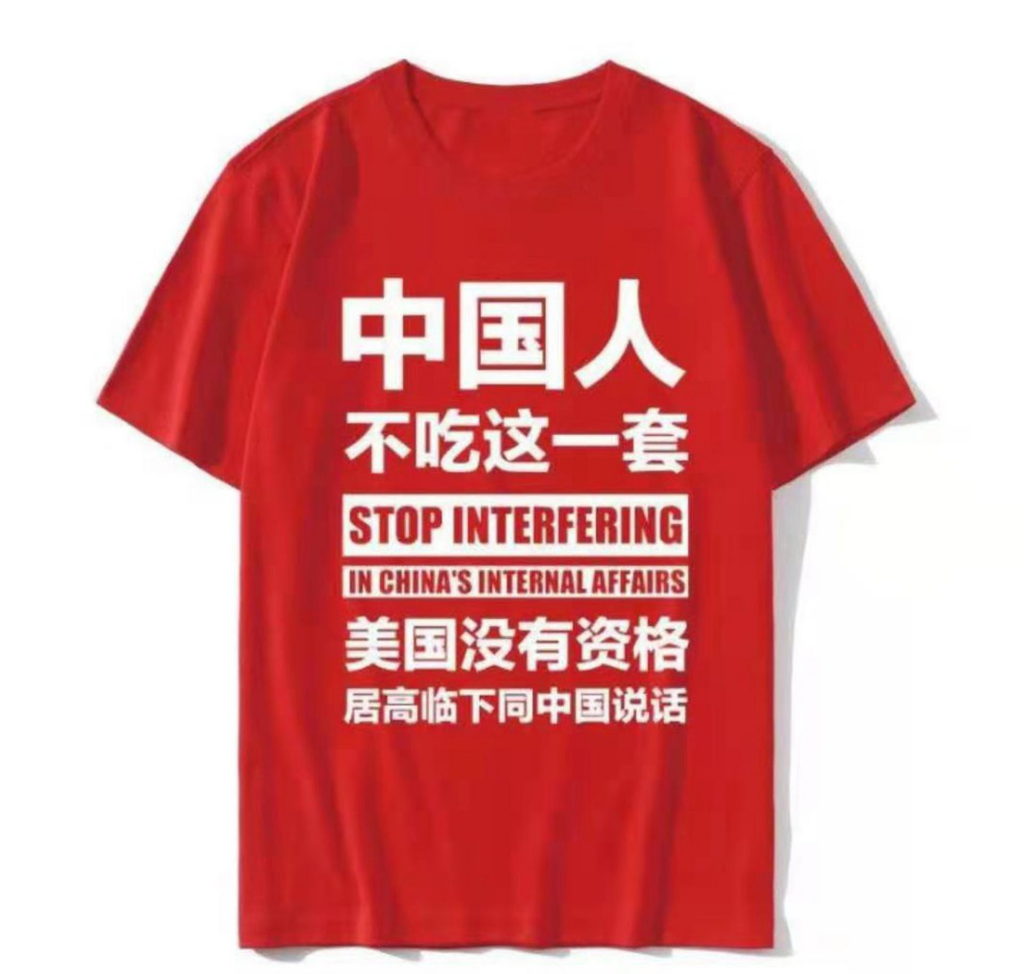Positions harden over Taiwan, Xinjiang and “democratic values” in new Cold War
Vincent Kolo, chinaworker.info
Joe Biden’s presidency, not yet 100 days old, has continued and intensified the anti-China policies of his predecessor Donald Trump. The president sums up his position in the slogan, “extreme competition”. Expectations in some quarters – including sections of the Chinese regime (CCP) – that the new Cold War between the superpowers would moderate after Trump left the White House have not materialised. Rather the direction is towards further escalation. This is what ISA warned before last November’s US election.
While Trump took a piecemeal and often erratic approach, “Biden is inheriting the destructive results of his predecessor and systematizing the China containment policy,” noted the Global Times, an influential CCP tabloid.
As we anticipated, the Democrats under Biden are adopting a more “ideological” approach, using issues like democracy and human rights as camouflage for what in reality is an imperialist power struggle to determine whether Washington or Beijing will exercise ultimate dominion over the global economy. “This is a battle between the utility of democracies in the 21st century, and autocracies,” Biden said in March at his first press conference as president. Plagiarising Trump, he said China planned to be the most powerful country in the world but “that’s not going to happen on my watch”. (Trump said the same in 2019).
Biden’s administration has retained all of Trump’s tariffs, which apply to 66 percent of China’s exports. Sounding much like her predecessor, Commerce Secretary Gina Raimondo defended the tariffs stating she would “use all the tools in my toolbox as aggressively as possible to protect American workers and businesses from unfair Chinese practices.”
Similarly, on technology, an increasingly central battlefield in the US-China Cold War, the US government announced in February a “100-day review” of supply chain resilience. Its focus will be blocking China’s access to cutting edge technologies like advanced semiconductors, which are crucial for both sides.
Those expecting the US to dial back on its tech war against China “will be disappointed” predicted James Crabtree of Singapore’s Lee Kuan Yew School of Public Policy. “Biden is likely to push forward with an evermore Chinese-style industrial policy,” he predicted. The aim being, “to cajole global chip suppliers to shift to the US, and deny China access to that industry’s most advanced products” (Nikkei Asia 10 March 2021). This of course, “negates market economy principles”, as Chinese Foreign Ministry spokesperson Zhao Lijian pointed out.
In April, in another move aimed at hobbling the development of China’s tech sector, Washington added seven more Chinese computer companies to its blacklist, the so-called Entity List, which cuts off their access to US components, citing links to China’s military. This was the first expansion of the blacklist since Trump left office. Trump’s administration placed more than 60 Chinese tech companies on the Entity List, most famously telecom giant Huawei, which has been severely affected.
Likewise, Biden’s proposed $2.25 trillion infrastructure package contains an explicit Cold War dimension. Announcing the plan in April, Biden mentioned China six times. As The Wall Street Journal (Gerald F. Seib, 5 April) noted, “The Biden team sees the plan – and wants the Chinese to see the plan – as a sign the US intends to put itself in better position to compete with Beijing economically. Thus, infrastructure marks just the latest example of how the specter of a long competition with China is beginning to color all manner of American policy moves, in both parties.” As this example also shows, the US-China rivalry is increasingly a weapon used by both sides to overcome internal opposition and engender a mood of ‘national unity’ behind government policy.
However, in the first months of 2021, it is the geopolitical conflicts between Beijing and Washington that have moved to centre stage. Tensions have risen over Xinjiang, Hong Kong, Taiwan, and disputed territories in the South China Sea. In Xinjiang, where millions of mainly Muslim Uighurs and other minorities face horrific repression, the State Department has accused the Chinese regime of “genocide” and hinted at a possible boycott of the 2022 Beijing Winter Olympics. In Taiwan, a dangerous poker game is unfolding in which both Beijing and Washington are raising the stakes with endless military manoeuvres and increasing psychological warfare.
Even in Myanmar, where a heroic revolutionary general strike movement is fighting to bring down the military dictatorship, there is a growing danger of a Cold War dynamic being injected into the situation should the army’s increasingly bloodthirsty tactics push the country over the brink into all-out civil war. In such a scenario, China, Russia, the US, and possibly other outside powers, could intervene for their own geopolitical reasons by sponsoring proxy forces, with little more than crocodile tears for the people of Myanmar.
The escalation of tensions in the vast Indo-Pacific region between US and Chinese imperialism, not in the form of a direct military confrontation at this stage, but following a tit-for-tat spiral of military drills, provocative diplomacy, bloc-building, and so-called ‘grey zone’ warfare, poses serious risks to the region’s economic development and creates a potential breeding ground for toxic nationalism and racism.
Disaster in Alaska
The first high-level meeting between Biden’s team and their Chinese counterparts, in Anchorage on 18-19 March, began with an extraordinary slanging match. On the eve of the meeting, the US State Department sanctioned a further 24 Chinese and Hong Kong officials in response to China’s decision to impose a new political system on Hong Kong, giving Beijing full control. The US sanctions were largely symbolic, in line with previous sanctions by Trump’s administration, but their timing raised the temperature for the Alaska meeting.
The Alaska meeting was “a disaster” according to economist Stephen Roach. “The situation is going from bad to worse and it doesn’t have to do that,” he lamented. This view was shared by Allison Sherlock of Eurasia Group, “Anyone who was hoping there would be a significant de-escalation – largely people in the business community – can see that’s not going to be possible, at least in the near term.”
The representatives of both governments used the meeting to grandstand to a wider audience. This was a historic but rather bizarre encounter with each side seeking to talk up their national strengths. US Secretary of State Antony Blinken lectured the Chinese not to “bet against America” and slammed China’s actions as a “threat to global stability”.
Yang Jiechi, the director of the Office of the Central Commission for Foreign Affairs and a member of China’s ruling Politburo, launched a scathing attack of the US record on human rights, its “long arm jurisdiction and suppression”, and declared that “China’s development and strengthening is unstoppable”.
Speaking for sixteen minutes without a pause for translation, clearly for the benefit of the Chinese media rather than his American hosts, Yang told the Americans not to talk down to China: “The United States does not have the qualification to say that it wants to speak to China from a position of strength.” Within days this statement had gone viral on China’s social media. Even tee shirts were selling printed with this slogan.
China’s momentum
The significance of Yang’s comments has been widely discussed in China and the US. Many Western observers were shocked. China has previously inflicted its jingoistic ‘wolf warrior’ diplomacy on lesser powers – Australia, Canada, Sweden, even the WHO’s formerly China-friendly director-general Tedros Adhanom Ghebreyesus – but never before in the modern era has it addressed US representatives in this way. Even in the face of Trump’s many provocative measures, official Chinese statements were relatively restrained.
“The Biden administration gets a taste of China’s ‘wolf warrior’ diplomacy”, was one headline in the Washington Post. Several US pundits conclude that Yang’s tirade was a sign of the Chinese regime’s rising self-confidence and sense of its global power. “Chinese leaders believe they have momentum and time is on their side,” former Chinese diplomat Victor Gao told the Financial Times.
In China too, the official and most common interpretation is that Yang articulated China’s superpower status as an equal or even superior force to the US. Chinese media gave extensive coverage to Yang’s speech and made comparisons with the humiliating ‘Boxer Protocol’ signed in 1901 between the decaying Qing Empire and the Eight-Nation Alliance of Western powers plus Japan, which forced China to pay crippling indemnities. The CCP’s People’s Daily published photos of the 1901 defeat and the Alaska meeting side by side to hammer home the message that 120 years later this is a different China.
Both the Chinese and US ruling classes need to whip up nationalism and an external threat to divert social unrest as crisis and rot afflicts their respective capitalist systems. Biden’s “America is back” is a remix of Trump’s “MAGA”, albeit with a different emphasis on building “democratic coalitions” against China. For the Chinese dictatorship there is an additional element: nationalism and anti-Western rhetoric are inextricably linked to Xi Jinping’s lifetime rule project and the power struggle inside the CCP-state. Xi plans to rule until 2035, which is an increasingly divisive issue within the ruling class.
But Beijing’s geopolitical and economic diplomacy, as illustrated by the Alaska meeting, is becoming entangled in contradictions. Clearly, the CCP’s top diplomats went to Alaska with more than just the intention of giving the US a tongue-lashing. While ‘wolf warrior’ nationalism and Chinese triumphalism are hallmarks of Xi Jinping’s rule, behind this façade there is deep insecurity.
There is mounting pressure within the Chinese state to try to defuse tensions or at least to build some ‘guardrails’ around the US-China relationship to prevent the conflict spinning further out of control. The old proverb about riding a tiger – that it’s hard to get off – applies to today’s ruling group. Xi’s nationalism and hardline repressive stance has become a constraint on the state’s ability to manoeuvre and show flexibility in its foreign policy, thereby increasing the risks for its export-dependent economy.
This predicament is highlighted in two editorials from the notoriously nationalistic Global Times. On April 9 it argued this was “not the right time to reason with Washington” while on April 15 the same editorial page argued, “China should strive to stabilize the framework of China-US relations, even if it is about fierce competition”.
Not surprisingly therefore, the Alaska meeting produced a number of contradictory messages from the Chinese government. Chinese officials described the meeting as a “strategic dialogue” referencing the framework of annual top-level meetings held during the Bush and Obama presidencies, which were scrapped by Trump. The US side begged to differ. “This is not a strategic dialogue,” Blinken said. “There’s no intent at this point for a series of follow-on engagements.”
Chinese media reported the two sides had agreed to set up a joint working group on climate change during the Alaska talks. But on this point too, US officials said no such agreement had been reached.
One possible interpretation is that Xi’s regime had higher hopes from the meeting; that at least some superficial diplomatic ‘bones’ would be thrown, allowing Beijing to present the meeting as progress and create an appearance of ‘stabilization’ in US-China ties. That the CCP, outwardly at least more than the US side, is looking for such a ‘time out’ is an indication of the real pressure it faces, economically and politically, as the conflict continues.
Beijing’s increasing resort to strategic exaggeration, its tendency to overplay its hand, hides serious weaknesses. This of course applies to both superpowers, both mired in debt, both built upon explosive social inequality, and both rooted in a global capitalist system in which they can no longer coexist without conflict.
There are deep concerns that China’s economy will be seriously hit by Western decoupling, which could accelerate if the Cold War dynamic of “choosing sides” takes hold. This after all is the whole point of Biden’s bloc-building approach of coordinating with (and strong-arming) US allies. Xi’s “dual circulation” strategy, launched in 2020, to focus on China’s domestic consumption as the key to expansion, works better as propaganda than as a realistic economic model.
China’s domestic consumption levels are very low by global standards and attempts over the past two decades to change this have failed. In 2001, when China joined the World Trade Organization, household consumption accounted for 45.5 percent of GDP. This fell to 34.3 percent in 2010, and has gradually recovered to 39 percent, according to the World Bank. This compares poorly even with other so-called developing economies, with ratios of 65 percent in Brazil, 60 percent in India and 50 percent in Russia.
Deep structural factors account for China’s low consumer spending; low wages and the lack of welfare and medical cover which forces people to save. These problems are now compounded by the demographic time bomb, of an aging and soon-to-be shrinking population, which also means a shrinking workforce. The real situation for China’s working class and poor is a million miles removed from the triumphalist propaganda of the CCP. Officially, extreme poverty has been eradicated – under Xi’s personal guidance (!) – but based on World Bank measurements China still has 200m living in extreme poverty.
The Chinese dictatorship has been unnerved by Biden’s immediate adoption of an aggressive Cold War stance. Beijing was expecting a longer breathing space, with Washington preoccupied by political and economic crises and the disastrous scale of the pandemic.
The Quad
One week before the Alaska meeting, on March 12, Biden presided over the first ever summit of the Quadrilateral Security Dialogue (Quad) with the leaders of Australia, Japan, India and the US. The Quad, which originated in the wake of the 2004 Indian Ocean tsunami, was previously little more than a talking shop. In the new Cold War, however, it is being revamped to act as a military and geopolitical counterweight to China in the Indo-Pacific. “China’s nightmare scenario of an ‘eastern NATO’ starts to take shape,” commented Shi Jiangtao in the South China Morning Post.

The timing of the “historic” Quad meeting as Biden’s very first summit was an unmistakeable warning to Beijing. The four countries had “taken the Quad to a new level” claimed Jake Sullivan, Biden’s national security advisor. A crucial shift has also occurred with India, previously lukewarm towards both the Quad and closer US ties, moving more emphatically into the US-led camp.
An important factor behind this turnaround is last year’s military conflict between China and India on their disputed Himalayan border, which caused their first military fatalities since 1967. This conflict, in India’s Ladahk region, known as “Little Tibet” due to its cultural and historical ties with China-controlled Tibet, had little logic other than to shore up the political authority of the Modi and Xi governments. China seems to have extracted some minor military gains from the confrontation, but at considerable cost in economic and geopolitical terms. As on many other fronts, Xi’s unyielding ‘wolf warrior’ approach is capable of securing short-term propaganda victories, but at the price of generating new crises and undermining China’s position in the longer term.
US arms sales to India jumped to $3.4 billion in 2020 from $6.2 million in 2019, and Modi’s government signed deals allowing US and Australian military forces to refuel at Indian bases. The US-led attempt to build up the Quad goes beyond military cooperation. At the March 12 summit it was agreed that Japan and the US would fund Indian production of a billion extra Covid-19 vaccine doses for distribution in Southeast Asia.
The Quad’s venture into ‘vaccine diplomacy’ is clearly designed to raise its profile as a counterpole to China’s growing influence across the region. But the initiative almost immediately ran into trouble. India, “the world’s pharmacy”, which produces 60 percent of all vaccines globally, announced a halt to vaccine exports at the end of March due to an upsurge in Covid-19 infections at home. The Global Times could not hide its sense of schadenfreude over New Delhi’s misfortune: “Rather than focusing on epidemic containment, India, by playing opportunism, triggered rounds of disputes with its neighbours, including China.”
Biden’s decision to invite Japan’s Prime Minister Yoshihide Suga to Washington in mid-April, his first face-to-face meeting with a world leader, reflects the same strategic messaging. Their talks focused on China and especially its military activities in the South and East China seas. The joint statement issued after the two leaders’ talks included a first reference to Taiwan’s security since 1969, an obvious provocation in Beijing’s eyes.
Suga’s tilt to a more openly confrontational stand towards China, despite it being Japan’s largest export market, reflects a wider hawkish shift in Japan’s ruling Liberal Democratic Party, with proposals circulating to emulate the US and conclude a defence treaty with Taiwan. Biden and Suga also committed to cooperate in areas such as 5G, artificial intelligence, quantum computing, genomics and semiconductor supply chains – all clearly aimed against China.
The US leader also wants to host a ‘Summit for Democracy’ later in the year as part of his push to revive an alliance of mainly Western “democratic” powers in a united front against “authoritarianism” – a convenient label for China but also Russia, Iran, North Korea and other regimes with separate agendas to US imperialism.
As Marxists and ISA have explained, while we support mass struggle against authoritarian rulers such as in Myanmar, Thailand and Hong Kong, the capitalists and imperialists are concerned only with economic control and in today’s Cold War environment, gaining geopolitical advantage at the expense of the other side. Provided these interests are served, political systems whether “democratic” or not are completely secondary for the US, China, and other imperialist ruling classes.
The US government provides military support to three-quarters of the world’s dictatorships, a greater number than China or Russia. To the question who is promoting authoritarianism and repressive rule, the answer is the capitalists and imperialists in both Cold War camps. As Myanmar has clearly shown, democratic rights require mass struggle by workers and youth, and this struggle cannot place its hopes in any of the competing powers.
EU-China deal “now on ice”
Despite its early apparent successes, Biden’s bloc-building strategy will inevitably encounter serious obstacles and setbacks. Both camps in the new Cold War are operating in a much more fragile and volatile environment than the Cold War of the 20th century. Unlike the formative years of that conflict, after the Second World War, the global economy is today plagued by serious, intractable crises.
The fate of China’s investment deal with the EU, the Comprehensive Agreement on Investment (CAI), is a useful lesson in how quickly things can change and supposed victories squandered. When, at the tail-end of 2020, this deal was signed between Xi Jinping and EU leaders, principally Merkel (Germany) and Macron (France), its was hailed as a geopolitical coup by China, potentially driving a wedge between Europe and the incoming Biden administration.
As we stated at the time:
“China may appear to have scored impressive diplomatic and economic victories over the US in the last period with RCEP and the China-EU deal, and the seemingly unstoppable extension of CCP power in Hong Kong, but these may be more about symbolism than substance. With increased economic contradictions and tensions in the next period, these ‘victories’ may quickly be forgotten and replaced with new conflicts.” (US-China Cold War – Will There Be Another World War? By Peter Chan, based on a speech delivered on 30 January 2021).
When the sanctions conflict escalated over Xinjiang in late March, with Beijing for the first time retaliating with (equally tokenistic) sanctions of its own against the US, Britain, Canada and the EU, this threw the CAI into crisis. The EU’s decision to join the US-led sanctions round especially angered, and apparently surprised, Xi’s regime. These were the first European sanctions against China since 1989. Political positions then hardened in the European Parliament – which has to ratify the deal – and in several European countries where politicians, NGOs, or think tanks were targeted by China’s payback sanctions. Both the EU and Xi’s regime received a lesson in the fact that nationalism and defending ‘national honour’ can be a two-way street.
“That pact’s ratification by the European Parliament is now on ice, and possibly entombed in permafrost, as a result of China’s sanctions on several Euro-legislators,” declared The Economist. The CCP’s apparent lack of finesse when it comes to understanding electoral politics is a possible explanation for why it chose to sanction politicians from across the spectrum of political parties instead of a more ‘tactical’ approach to limit the backlash.
That a deal favoured by capitalists and big companies in both Europe and China now hangs in the balance shows again how capitalism has moved into the era of ‘geo economics’, which is another term for inter-imperialist conflict. “We had seven years of negotiations for the deal,” Joerg Wuttke, head of the European Chamber of Commerce in China, told the Financial Times. “Now it looks like it will take another seven years.”
The sanctions game from all sides is cynical and hypocritical. Using the ‘Magnitsky Act’ model, these sanctions are the diplomatic equivalent of mosquito bites, targeting individuals, government officials or institutions, with travel and financial restrictions, but doing only symbolic damage. Some sections of the democracy movement in Hong Kong for example, and also some Uighur exiles groups, have been misled into believing these sanctions make a difference. But there is not a single example where this has changed national policies, repressive or otherwise. Rather they allow governments to posture in defence of ‘principles’ and at the same time fan nationalism. This complicates instead of assisting the development of mass struggle, which is the only way to win equality, democratic rights and an end to repressive rule.
In the UK, among several Tory politicians hit by China’s sanctions, is Iain Duncan Smith, a former leader of the right wing Conservative Party who has latterly become a critic of human rights abuses in China and Hong Kong. Evidently enjoying his sudden heroic status, Duncan Smith said he would wear the Chinese sanctions as a “badge of honour”.
But this is the same Duncan Smith who was a minister in David Cameron’s government, which in 2015 proclaimed a “golden era” in UK-China relations and claimed to be China’s “best partner in the West”. Accordingly, in the same year, the UK became the first Western country to sign up as a founding member of Xi Jinping’s Asian Infrastructure Investment Bank (AIIB), the financial arm of the Belt and Road Initiative (BRI) in Asia. This drew a sharp rebuke from the Obama administration about “a trend toward constant accommodation of China” by Cameron’s government.
When liberal pro-democracy figures Anson Chan Fang On-sang and Martin Lee Chu-ming from Hong Kong visited London in 2014 to build support for democratic reform, Cameron refused to meet them. Lee later said, “I think I can sum up the foreign policy of the British government in three words: more China trade”. At this time, Hong Kong was engulfed in mass protests known as the Umbrella Revolution against the CCP’s refusal to allow elections based on one-person-one-vote to choose the territory’s Chief Executive. The British government, in which the now-sanctioned Duncan Smith served, again sided with the CCP, telling Hong Kongers that Beijing’s offer was “better than nothing” (Huge Swire, Minister of State for the Foreign Office, addressing a parliamentary committee, January 2015).
Xinjiang Cotton
Also in late March, more controversy over Xinjiang cotton – involving credible claims of forced labour – erupted when the Communist Youth League, an arm of the CCP-state, targeted Swedish fashion retailer H&M in order to launch an online boycott campaign, which widened to target more foreign brands including Nike, Adidas and Zara.
Rather than a spontaneous grassroots protest against the Western brands, this campaign was orchestrated by the state. In terms of striking a popular chord among the masses the campaign seems to have met a very lethargic response. H&M was however suddenly erased from the internet in China, its stores disappeared from online maps (apart from Google Maps which is blocked in China) and ride hailing apps, and its products no longer featured on e-commerce giants Alibaba and JD.com.
H&M’s statement that it would no longer source cotton from Xinjiang was issued last October, and lay dormant until the League decided to make an issue of it in March. The timing – just days after the sanctions dispute flared with the EU – was hardly coincidental and intended to exert pressure on European governments to correct their “mistaken actions” in imposing sanctions on China.
Previous nationalist boycott campaigns, for example against South Korean supermarket chain Lotte (over the county’s installation of THAAD missiles), and the NBA (over a pro-Hong Kong tweet by the general manager of the Houston Rockets basketball team) have generally faded out with time. But in today’s increasingly polarised Cold War environment the likelihood increases that political pressures will add extra weight to the decoupling process. “I don’t expect this to die down,” Surya Deva, an associate professor at the City University of Hong Kong, told the New York Times. “This is a different trajectory and a different era.”
The issue of an Olympic boycott in 2022 is likely to grow despite the fact that the Biden administration is, based on its statements so far, against. The changing global landscape puts additional demands and pressure upon socialists and worker activists not to be sidetracked or hoodwinked into supporting one or other of the belligerent imperialist camps. Such mistakes are already evident in some sections of the left but also in emerging anti-authoritarian struggles – either leaning towards the US camp in the mistaken belief that its “democratic” claims actually count for something, or supporting Xi’s pro-capitalist dictatorship in the mistaken belief it is engaged in “anti-imperialism”.
The task of ISA is to expose with hard facts and clear analysis both Cold War camps. We explain that it is only the working class, not any of the capitalist governments, that can lead a way out of humanity’s crisis, and this requires the workers’ movement to preserve its political independence, build its organisations, and combine across national borders around the program of international socialism.






